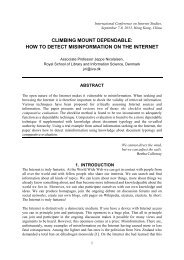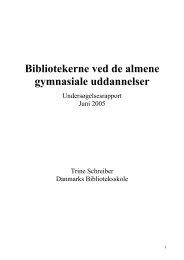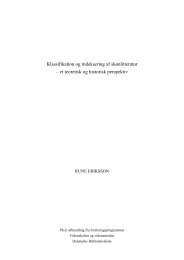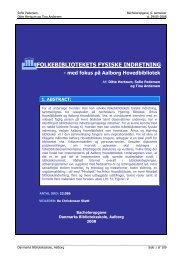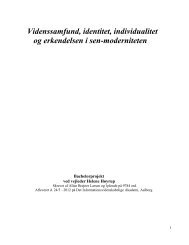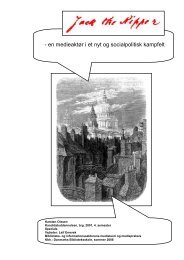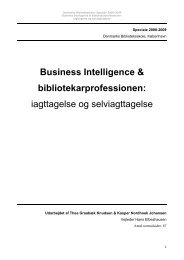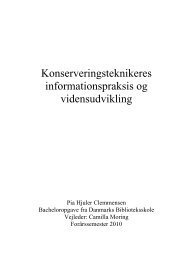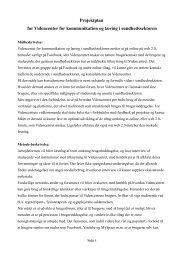Hvorfor er det sjovt at surfe på nettet? - Forskning
Hvorfor er det sjovt at surfe på nettet? - Forskning
Hvorfor er det sjovt at surfe på nettet? - Forskning
You also want an ePaper? Increase the reach of your titles
YUMPU automatically turns print PDFs into web optimized ePapers that Google loves.
83<br />
Und<strong>er</strong>holdende int<strong>er</strong>netsøgning<strong>er</strong> – S<strong>er</strong>ena Borsello<br />
Rettie, R. (2001). An explor<strong>at</strong>ion of flow during Int<strong>er</strong>net use. Int<strong>er</strong>net Research, 11(2), 103‐<br />
113.<br />
Rieh, S.Y. (2004). On the Web <strong>at</strong> home: Inform<strong>at</strong>ion seeking and Web searching in the home<br />
environment. Journal of the Am<strong>er</strong>ican Society for Inform<strong>at</strong>ion Science and<br />
Technology, 55(8). 743‐753.<br />
Rieh, S.Y. & Hilligoss, B. (2008). College students´ credibility judgments in the inform<strong>at</strong>ion‐<br />
seeking process. I: Metzg<strong>er</strong>, M., J. & Flangian, A.J. (Eds.). Digital Media, Youth, and<br />
Credibility (49‐72). The MIT Press.<br />
Ryan, C. & Rao, U. (2008). Holiday us<strong>er</strong>s if the int<strong>er</strong>net: Ease of use, functionality and<br />
novelity. Int<strong>er</strong>n<strong>at</strong>ional Journal of Tourism Research, 10, 329‐339.<br />
Ryan, R.M, Rigby, C S. & Przybylski, A. (2006). The motiv<strong>at</strong>ional pull of video games: A self‐<br />
<strong>det</strong><strong>er</strong>min<strong>at</strong>ion theory approach. Motiv<strong>at</strong>ion and Emotion, 30(4), 344‐360.<br />
San José‐Cebezudo, R., Gutiérrez‐Cillán, J. & Gutiérrez‐Arranz, A.M. (2008). The mod<strong>er</strong><strong>at</strong>ing<br />
role of us<strong>er</strong> motiv<strong>at</strong>ion in Int<strong>er</strong>net access and individuals´ responses to a<br />
Website. Int<strong>er</strong>net Research, 18(4), 393‐404.<br />
Saracevic, T. (2009). Inform<strong>at</strong>ion science. I: B<strong>at</strong>es, M.J. & Maack, M.N. (Eds.). Encyclopedia of<br />
Library and Inform<strong>at</strong>ion Science (s. 2570‐2586). Taylor & Francis.<br />
Savolainen, R. (2004). Enthusiastic, realistic and critical: Discourses of Int<strong>er</strong>net use in the<br />
context of ev<strong>er</strong>yday life inform<strong>at</strong>ion seeking. Inform<strong>at</strong>ion Research, 10(1), pap<strong>er</strong><br />
198. Tilgængelig online <strong>på</strong> http://inform<strong>at</strong>ionr.net/ir/10‐1/pap<strong>er</strong>198.html<br />
(sidst v<strong>er</strong>ific<strong>er</strong>et s. 27/06/2011).<br />
Savolainen, R. (2007), Media credibility and cognitive authority: The case of seeking<br />
orienting inform<strong>at</strong>ion. Inform<strong>at</strong>ion Research, 12(3), pap<strong>er</strong> 319. Tilgængelig<br />
online <strong>på</strong> http://inform<strong>at</strong>ionr.net/ir/12‐3/pap<strong>er</strong>319.html (sidst v<strong>er</strong>ific<strong>er</strong>et d.<br />
27/06/2011)<br />
Savolainen, R. & Kari, J. (2004). Conceptions of the Int<strong>er</strong>net in ev<strong>er</strong>yday life inform<strong>at</strong>ion<br />
seeking. Journal of Inform<strong>at</strong>ion Science, 30(3), 219‐226.<br />
Scealy, M., Phillips, J.G. & Stevenson, R. (2002). Shyness and anxiety as predictors of<br />
p<strong>at</strong>t<strong>er</strong>ns of int<strong>er</strong>net usage. Cyb<strong>er</strong>Psychology & Behavior, 5(6), 507‐515.<br />
Schramm, H. & Wirth, W. (2008) A case for an integr<strong>at</strong>ive view on affect regul<strong>at</strong>ion through<br />
media usage. Communic<strong>at</strong>ions, 33, 27‐46.<br />
Segev, E. & Ahituv, N. (2010). Popular searches in Google and Yahoo!: A “digital divide” in<br />
inform<strong>at</strong>ion uses? The Inform<strong>at</strong>ion Society, 26(1), 17‐37.<br />
Shneid<strong>er</strong>man, B. (2004). Designing for fun: Can we design us<strong>er</strong> int<strong>er</strong>faces to be more fun?<br />
Int<strong>er</strong>actionFunology, 11(5), 48‐50.<br />
Slone, D. J. (2002). The influence of mental models and goals on p<strong>at</strong>t<strong>er</strong>ns during Web<br />
int<strong>er</strong>action. Journal of the Am<strong>er</strong>ican Society for Inform<strong>at</strong>ion Science and<br />
Technology, 53(13), 1152‐1169.<br />
Sp<strong>er</strong>ring, S. & Strandvall, T. (2008). View<strong>er</strong>s´ exp<strong>er</strong>ience of a TV quiz show with integr<strong>at</strong>ed<br />
int<strong>er</strong>activity. Int<strong>er</strong>n<strong>at</strong>ional Journal of HumanComput<strong>er</strong> Int<strong>er</strong>action, 24(2), 214‐<br />
235.



